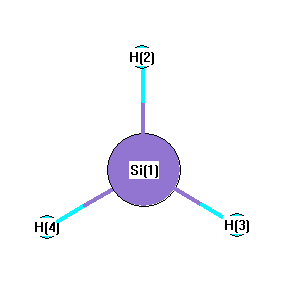Geometric Data

Point Group D3h
Internal coordinates
distances (r) in Å, angles (a) in degrees, dihedrals (d) in degrees
| Description |
Value |
unc. |
Connectivity |
Reference |
Comment |
| Atom 1 |
Atom 2 |
Atom 3 |
Atom 4 |
| rSiH |
1.460 |
0.010 |
1 |
2 |
|
|
1994Dav/Smi:6166 |
re |
| aHSiH |
120 |
|
2 |
1 |
3 |
|
|
by symmetry |
Cartesians
| Atom |
x (Å) |
y (Å) |
z (Å) |
| Si1 |
0.0000 |
0.0000 |
0.0000 |
| H2 |
0.0000 |
0.0000 |
1.4600 |
| H3 |
0.0000 |
1.2644 |
-0.7300 |
| H4 |
0.0000 |
-1.2644 |
-0.7300 |
Atom - Atom Distances 
Distances in Å
| |
Si1 |
H2 |
H3 |
H4 |
| Si1 |
|
1.4600 | 1.4600 | 1.4600 |
| H2 |
1.4600 |
|
2.5288 | 2.5288 |
| H3 |
1.4600 | 2.5288 |
|
2.5288 |
| H4 |
1.4600 | 2.5288 | 2.5288 |
|
Calculated geometries
for SiH
3+ (Silyl cation).
Experimental Bond Angles (degrees) from cartesians 
| atom1 |
atom2 |
atom3 |
angle |
|
atom1 |
atom2 |
atom3 |
angle |
| H2 |
Si1 |
H3 |
120.000 |
|
H2 |
Si1 |
H4 |
120.000 |
| H3 |
Si1 |
H4 |
120.000 |
Bond descriptions
Examples: C-C single bond, C=C, double bond, C#C triple bond, C:C aromatic bond
Connectivity
| Atom 1 |
Atom 2 |
| Si1 |
H2 |
| Si1 |
H3 |
| Si1 |
H4 |







